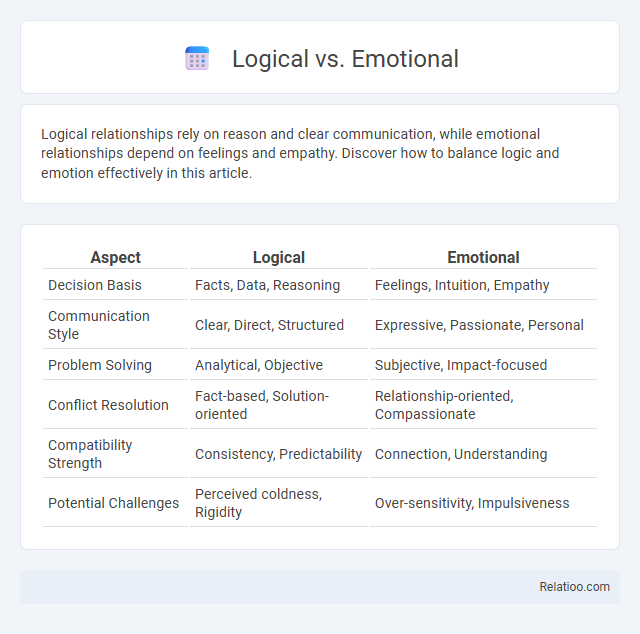Logical relationships rely on reason and clear communication, while emotional relationships depend on feelings and empathy. Discover how to balance logic and emotion effectively in this article.
Table of Comparison
| Aspect | Logical | Emotional |
|---|---|---|
| Decision Basis | Facts, Data, Reasoning | Feelings, Intuition, Empathy |
| Communication Style | Clear, Direct, Structured | Expressive, Passionate, Personal |
| Problem Solving | Analytical, Objective | Subjective, Impact-focused |
| Conflict Resolution | Fact-based, Solution-oriented | Relationship-oriented, Compassionate |
| Compatibility Strength | Consistency, Predictability | Connection, Understanding |
| Potential Challenges | Perceived coldness, Rigidity | Over-sensitivity, Impulsiveness |
Understanding Logical Thinking
Understanding logical thinking involves recognizing how your rational mind processes information through facts, evidence, and structured reasoning to solve problems effectively. Logical needs demand clarity, consistency, and objective analysis, helping you make informed decisions without being swayed by emotional biases. Balancing logical thinking with emotional needs enhances your overall judgment and supports well-rounded, practical solutions.
Exploring Emotional Reasoning
Emotional reasoning involves interpreting situations based on feelings rather than objective facts, often leading to biased conclusions that may not reflect reality. Your ability to recognize when emotions influence your thinking can improve decision-making and reduce cognitive distortions. Exploring emotional reasoning enhances awareness of the interplay between logical thought and emotional needs, fostering balanced and informed responses.
Key Differences Between Logic and Emotion
Logical needs are driven by objective reasoning, facts, and clear evidence, while emotional needs arise from feelings, desires, and personal values. Your decision-making often balances these by integrating rational analysis with emotional responses to achieve well-rounded outcomes. Understanding the key differences between logic and emotion enhances clarity in problem-solving and supports more effective communication.
The Science Behind Logic and Emotion
The science behind logic and emotion reveals distinct neural pathways where the prefrontal cortex governs logical reasoning, while the limbic system manages emotional responses, highlighting how the brain processes rational and affective information differently. Emotional needs drive behavior through subconscious motivations linked to survival and social bonding, whereas logical needs are met through deliberate problem-solving and decision-making processes. Understanding these mechanisms aids in balancing emotional satisfaction with logical reasoning for optimal decision outcomes.
Real-Life Applications of Logical vs Emotional Decisions
Logical decisions rely on objective analysis and factual data, while emotional decisions are driven by feelings and personal values, impacting outcomes in everything from business to personal relationships. Emotional needs often motivate choices related to comfort, security, and social connection, whereas logical needs emphasize efficiency, problem-solving, and goal achievement. Understanding the balance between your logical reasoning and emotional impulses is essential for making well-rounded decisions that address both practical requirements and personal fulfillment.
Benefits of Logical Decision-Making
Logical decision-making enhances problem-solving by relying on clear data and objective analysis, minimizing emotional biases and errors. It promotes consistency and reliability in outcomes, supporting long-term planning and risk assessment. Businesses benefit from logical choices through improved resource management, efficiency, and measurable goal achievement.
Advantages of Emotional Responses
Emotional responses enable deeper human connection by tapping into feelings such as empathy, trust, and passion, which drive decision-making more effectively than purely logical analysis. These responses enhance brand loyalty and customer engagement by creating memorable experiences that resonate on a personal level. Leveraging emotional needs helps marketers and communicators foster motivation and long-term commitment, leading to increased retention and satisfaction.
Common Misconceptions About Logic and Emotion
Common misconceptions about logic and emotion often involve the belief that logic is purely rational while emotion is irrational, ignoring how they frequently interact to shape decision-making. Your emotional needs influence cognitive processes, showing that logic and emotion are not mutually exclusive but complementary in understanding human behavior. This integrated perspective helps clarify why decisions based on both reasoning and feelings tend to be more balanced and effective.
Balancing Logic and Emotion for Better Outcomes
Balancing logic and emotion is essential for better decision-making outcomes, as it allows you to integrate rational analysis with personal values and feelings. Logical needs prioritize facts, structure, and clear reasoning, while emotional needs address feelings, empathy, and personal connections. Recognizing and harmonizing both aspects ensures more comprehensive solutions that satisfy your intellectual and emotional well-being.
Tips to Strengthen Both Logical and Emotional Skills
Strengthening both logical and emotional skills requires consistent practice in critical thinking and emotional intelligence exercises. Engage in activities such as analyzing complex problems to sharpen analytical reasoning while practicing mindfulness and empathy to enhance emotional awareness and regulation. Combining cognitive strategies with emotional reflection supports balanced decision-making and effective interpersonal communication.

Infographic: Logical vs Emotional
 relatioo.com
relatioo.com